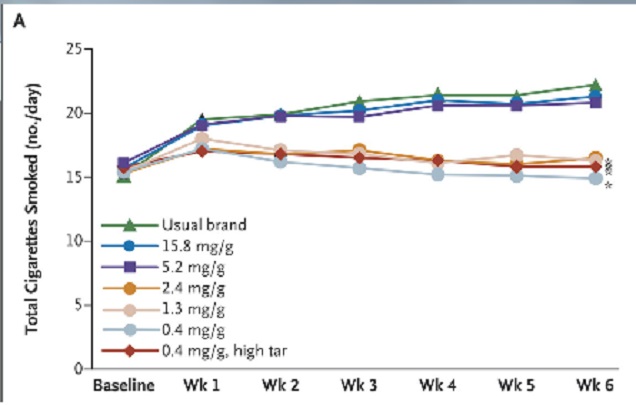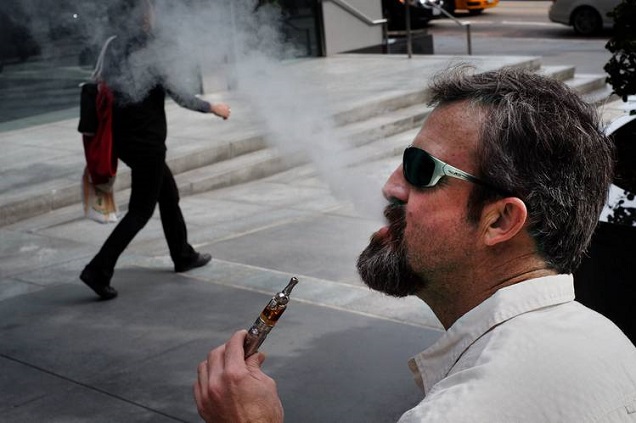
The Week in Vaping is back, offering a run-down of the latest vaping and tobacco harm reduction related research, a look at recently proposed legislation, regulations and bans on vaping – increasingly frequently stretching outdoors – and some of the best blog posts from the community this week.
Vaping-Related Research
One of the now-pointless tobacco control ideas for bringing about their “endgame” fantasy of a tobacco-free world – to reduce the nicotine content of cigarettes – has been tested in a new study. Anti-smoking groups claim that the study showed that smokers assigned low-nicotine cigarettes reduced their smoking, but as Michael Siegel points out, the study found no such thing: there was no difference in the number of cigarettes smoked after switching to the lower-nicotine cigarettes.

Brad Rodu has written an interesting blog post on the formaldehyde-cancer link, central to many fears about vaping – based on the absurd idea that vapers just love the taste of dry puffs – arguing that the conclusion that formaldehyde causes cancer is based on weak evidence. He says “It turns out that the formaldehyde-cancer link is weak to nonexistent, and it has been grossly exaggerated,” using evidence from several studies and meta-analyses calling the idea into question. The central study in establishing the link failed to account for other relevant risk factors, like exposure to sulfuric acid and metal mists.
Despite gateway fears driving harsh legislation in Wales, the Welsh Health Survey has found yet more evidence that non-smokers taking up vaping is very rare indeed. The survey couldn’t even find a single current vaper who had never smoked in the past. The Ashtray Blog wrote a post with a title that perfectly sums up what happened, “Welsh Gov E-Cig Gateway Theory Destroyed by its Own Evidence.”
Regulations, Legislation and Vaping Bans
Totally Wicked has written a blog post about the court hearing for their Article 20 legal challenge, detailing how their barrister argued their case well, but they fear he was drowned out by the opposing arguments put forward by the representatives of the UK, France, Spain and the EU’s parliament, council and commission. These trod the familiar ground that “we just don’t know yet,” and so should be cautious (to not “repeat past mistakes”). They even mentioned gateways and used “dying babies” as a justification for the proposed rules. The advocate general is set to give an opinion on the 17th of December, with the ruling coming early next year. EU vapers can only hope the court sees reason.
The city of Oviedo, Florida has banned vaping at city buildings and parks, citing complaints from parents as the rationale. One park visitor unintentionally summed up the level of scientific literacy backing up the decision, saying about vaping: “If it still has some sort of smoke in it, I wouldn't want my nieces and nephews around something like that.” No, it really doesn’t have “some sort” of smoke in it.

The town council of Truro, Nova Scotia has unanimously voted to ban vaping on all public property, including a park. The Nova Scotia Health Authority’s Tobacco Reduction Strategy coordinator repeated a lot of ill-supported nonsense and precautionary fears at the council – e-cigs “are a gateway” and we don’t know if they’re safe yet, don’t you know? – and they swallowed it.
Wheaton, Illinois has also voted to bring in an ordinance banning vaping in all enclosed public places, outdoor dining areas, at outdoor events, in parks, and anywhere on the sidewalk within 25 feet of entrances to buildings, outdoor dining areas or outdoor events. A similar ban has also been approved for next year in Durham County, North Carolina.
Cerritos City Council in California is considering banning new e-cigarette stores – actually extending a rule that was put in place in 2013 and is due to expire – leaving the single vape store as the only brick-and-mortar location smokers interested in vaping could pick up the safer alternative. Cigarettes, as always, remain widely available.
Other Vaping-Related News and Blog Posts
Four Pennsylvania high school students have been arrested for vaping on a school bus, under legislation banning the use of tobacco in schools, which includes “smokeless tobacco in any form.” This has apparently been interpreted as meaning anything containing nicotine even if there’s no tobacco, so students: remember not to eat nicotine-containing products like tomato or eggplant in schools.
A great blog post on Nicotine Science and Policy argues that restricting e-cigarette advertising would be “a major own goal for public health,” pointing out that rare use by teen non-smokers does not mean adult smokers should suffer.
By analogy, if a national health service discovered that a new vaccine saved one in three people affected by cancer, but a general population survey showed that the vaccine was being occasionally consumed by 1% of people who did not have cancer but without serious adverse effects, the health service would surely conclude that advertising this vaccine would likely prevent magnitudes of harm more than it would cause.
E-Cig Intelligence has released a new report (excerpt available) on the evolution of the US vaper, finding that box mods have skyrocketed in popularity in 2015 and that fewer than 5 percent use cigalike devices.

Along the same lines, there’s also a great post on Guide to Vaping about the fact that box mods are set to be available in Wal-Mart, with some interesting discussion (both in the post and the comments) about whether this will be a good thing for the vaping industry, and whether it will be good for interested smokers who'd otherwise just try a cigalike. Personally, I lean towards the view of the skeptics: providing higher-end devices with zero support may put more people off vaping than it turns onto it, but there are good points made on both sides.
A new e-liquid claims to “enhance function” in men (no prizes for guessing which type of “function”) thanks to the inclusion of a Malaysian herb called Tongkat Ali, but the research on the effects of this herb certainly aren’t as clear-cut as the peddlers of the e-liquid would have you believe.
E-Cigarette Direct’s Ashtray Blog has an informative post on temperature control vaping, giving the low-down on what you need to know to decide whether to take the plunge and upgrade to a TC mod.
A Forbes article looks at the ways vapers can help smokers make the switch, in particular by teaching them about using e-cigarettes, including the sort of devices to choose, how to get the most out of vaping and what to expect when they switch. Vapers helping smokers quit is something we wholeheartedly support, especially since public health seems more concerned with making them unduly worried about the potential minor risks of vaping.
Finally, Kanger have announced that the Nebox is available for pre-order, a 60 W device with temperature control that takes many cues from Joyetech's eGrip, being an “all-in-one” style mod with an in-built atomizer.
Bullshit of the Week – “Smokeless tobacco no safer than cigarettes”

In an article doomed to the slush-pile of unscientific claptrap from the headline alone, the Las Vegas Review Journal makes the bizarre argument that smokeless tobacco isn’t safer than smoking, because it contains nicotine and harmful chemicals that “can cause oral cancer, gum disease and a variety of medical and dental problems.” It might not be about vaping, but this anti-smokeless tobacco bullshit is basically the blueprint for how to scare smokers away from safer alternatives, and it’s still going strong.
Without even questioning the strength of the oral cancer link, it’s obvious that claiming that the presence of nicotine and the risk of one type of cancer is equivalent to the abundant health risks of smoking is thoroughly absurd. For anyone reading (pre-schoolers, maybe?) who doesn’t realize, cigarettes contain nicotine and cause numerous cancers and other health outcomes. Even based on the information in this disastrous post, the reduced harm conclusion is unavoidable.
In the comments, Carl V. Phillips annihilates the post:
Transcribing the scientific ignorance of some local official, without doing any research or consulting with an expert on the topic, is irresponsible journalism. Such irresponsibility can be deadly when the topic is about health choices. This article is functionally equivalent to writing an article based entirely on the scientifically false claims of an anti-vaxxer.
The reality is that smokeless tobacco use is estimated to be in the order of 99% less harmful than smoking. Indeed, if it does cause any life-threatening diseases, it is at such a low rate that it is undetectable. That is, using smokeless tobacco rather than smoking is almost exactly as beneficial as being abstinent from tobacco rather than smoking. Yet Ms. Azzarelli – and Mr. Przybys – are telling everyone who uses smokeless tobacco that they might as well smoke. That advice is as blatantly inaccurate as it is deadly.
They closed the comments after just five people chimed in explaining why journalists should consider this “research” thing we hear so much about before discouraging them from making potentially life-saving decisions.
Check Back Next Week for More!
As always, we’ve really just scratched the surface of what’s been going on in the world of vaping, but this week has been somewhat depressing: with outdoor vaping bans still picking up steam and tobacco control continuing to succumb to confirmation bias in the extreme when it comes to evidence, it’s a reminder that if vapers don’t stand up for their rights, we’ll be crushed under the weight of ill-informed propaganda. “Think of the children,” they say, restricting vaping as the adults continue to smoke themselves to death.

